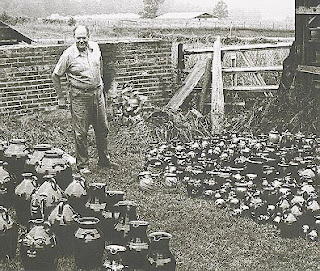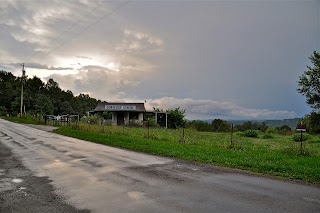In an earlier post, I called for the death of the arguable thesis (http://jrosspeters.blogspot.com/2011/08/death-to-arguable-thesis-before-we.html). In short, I asserted that we should teach our students to discover a belief before we allow them to worry about whether their claim is arguable. Several of the responses to the piece echoed a similar sentiment, which was most succinctly expressed by one of my favorite colleagues of all time and certainly someone who should be in the Hall of Fame of writing teachers, Patsy Steimer, who taught generations of Providence Day School students how to collaborate and how to write well. She wrote in part:
I also found it helpful to explain the idea of "arguable thesis" (a term which they will encounter at various points in their academic careers) as a conclusion. First, you make careful, thoughtful observations and collect promising evidence. THEN, you draw a conclusion. That is your thesis.
The idea of the thesis being a conclusion jives well with the idea of helping students discover actual beliefs instead of slipping into a cynical approach that involves “making up a thesis.”
The relevance of this way of thinking about thesis creation is that it allows us to understand the necessity of substantial expressive writing coming before transactional writing in the drafting stages of an essay assignment. Expressive writing is what we use to gather relevant information, to sort it out, to prioritize it, and to figure out what we believe about it. Expressive writing has an audience of one—the writer him or herself. Expressive writing allows students the space in which to arrive at a belief, and when done at the right moment, it likely results in what look like “up-side-down” first drafts (or maybe more accurately, "pre-drafts"*)—that is, writing in which the thesis appears at the end rather than the beginning. Only when students have arrived at this up-side-down moment are they positioned well for the move toward transactional writing, in which the audience is others. The transition to transactional writing involves turning the essay right-side-up so that students present the belief/thesis first and proceed to demonstrating the validity of the belief/thesis in the essay that follows. In its simplest form the idea is this: first a student writes to discover a belief/thesis and then the student, in order to teach an audience about it, states it in an introduction and then shows an audience HOW he or she reached that belief/thesis. I believe the best essays are most often a result of separating these two very different writing tasks.
When I think about what issues trip up students most consistently in their writing, organization comes immediately to mind. Interestingly, by expanding our commitment to expressive writing, we give students a logical path to follow in order to organize successfully. When students believe what they are writing, they are far less likely to be stumped about what to include or where in the essay to include it because they only need to revisit the details that made the case compelling to them in the first place. The demand is to retrace for an audience why the author has arrived at the belief/thesis he or she has reached. Using this approach students will not have to face the ridiculous task of trying to make their audience care about and believe an argument that the author does not care about or believe.
When I think about what issues trip up students most consistently in their writing, organization comes immediately to mind. Interestingly, by expanding our commitment to expressive writing, we give students a logical path to follow in order to organize successfully. When students believe what they are writing, they are far less likely to be stumped about what to include or where in the essay to include it because they only need to revisit the details that made the case compelling to them in the first place. The demand is to retrace for an audience why the author has arrived at the belief/thesis he or she has reached. Using this approach students will not have to face the ridiculous task of trying to make their audience care about and believe an argument that the author does not care about or believe.
Every time we grade final drafts in which the true belief/thesis appears to be in the concluding paragraph, teachers of writing see the negative effects of inattention to expressive writing in our teaching of the writing process. Additionally, if we do not give students time to write expressively and revise carefully, many of them are likely to turn in essays that never mature beyond the expressive stage or perhaps worse, that conflate the expressive and transactional tasks. This points to the need to expand our commitment to the earliest stages in the writing process to a degree that at minimum parallels the time we give to the editing stage. In truth, particularly with older students, the scale should tip toward spending more class-time on expressive writing and revision work.
With a primary focus on revision tasks, writing groups (made up of four or five students) ought to be a complement to the effort students make to complete the move from an early expressive draft to a transactional draft. Writing groups, in order to work successfully beyond the “peer editing” role to which they are at times limited, should play a significant role at the moment students have transitioned from the expressive stage to the transactional one. Unfortunately, as writing teachers we often collapse the time we would spend here in order to quiet the drum beat of approaching deadlines and content coverage demand. Our students, however, pay a high price for this compromise as it allows our students to slip into a cynical approach to writing assignments.
I have been disheartened to see many writing teachers retreat from writing groups over the last number of years. I also feel as if many of us have fallen short in providing enough time for the expressive writing our students need. As we engage conversations about the need to emphasize skills over content, our neglect of these key elements will betray us. If our goal, our biggest goal, is to help students become better readers, listeners, thinkers, speakers, and writers, we will find ourselves in an indefensible position if we fail to commit our time and energy to the very teaching and learning approaches that best meet the demands of that goal.
* Because I believe the term is inadequate to capture the writing task necessary in the early stages of the writing process, I avoided using the term "pre-writing," which has long been in use to describe writing that students do at the beginning of the essay writing process. Too often students have used pre-writing to capture the information that supports a thesis they have already chosen. In this way pre-writing as it has been used by teachers can inadvertently subvert discovery of belief, and it becomes a sort of essay writing back-fill, as if a builder can build the house and provide the foundation later. My problem therefore is not the term, pre-writing, but rather the baggage it brings with it.
* Because I believe the term is inadequate to capture the writing task necessary in the early stages of the writing process, I avoided using the term "pre-writing," which has long been in use to describe writing that students do at the beginning of the essay writing process. Too often students have used pre-writing to capture the information that supports a thesis they have already chosen. In this way pre-writing as it has been used by teachers can inadvertently subvert discovery of belief, and it becomes a sort of essay writing back-fill, as if a builder can build the house and provide the foundation later. My problem therefore is not the term, pre-writing, but rather the baggage it brings with it.
______________
Just in case someone finds it useful, I have included some examples of the advice I handout to writing groups as they approach their work together:
1. Read papers out loud slowly and clearly.
2. Plan your time so that each paper gets equal time.
3. Listen carefully. The key to successful writing groups is taking an interest in the success of others. In order to get a lot, you have to give a lot.
4. Focus on revision first rather than editing. When you are reading someone else’s paper ask yourself questions such as: Is the writing clear? Is the author catching your interest? Is everything the author included necessary? Is there unnecessary information included? What are the specific strengths of the paper? What are the specific weaknesses? Please write down your responses to the paper and be as specific as you can.
5. If you are not getting feedback from your group, ask questions to elicit responses.
6. Focus attention first on opening paragraphs—
a) Is there an well-articulated thesis?
b) Does the introduction lead/funnel to the thesis?
c) Is it engaging?
c) Is it engaging?
7. Next look at the body paragraphs of the essay—
a) Do they clearly support the thesis?
b) Does the author provide support for his/her important assertions?
c) Where could the author be more specific? More clear? More organized?
d) What is the strongest aspect of the paper? What is most in need of revision?
8. When in doubt about how to proceed, try different ways of focusing. For example, ask yourself or other members of the group—“if you had to add 100 words (or a new paragraph) to your paper, what would you add and why?” OR “If you had to take out 100 words what would you take out and why?” If you have time you can even write out your answer to the first question.
9. Another way of focusing on revision is to look at an entire paragraph or section of your paper and choose the sentence that, while it may be O.K., could be better. Write out two possible revisions for that sentence. Use your writing group to help you choose the sentences that are the best candidates for this type of revision. Remember: the first way we express our ideas is not always the most concise, the most accurate, or the most articulate way.
10. When you are working with the papers in your group, make sure the authors are varying their sentences.
11. Look for examples of authors telling something that they could better show through the use of detail/textual evidence.
12. Do a good job of listening to what your group tells you and thinking about how to make positive use of their comments. For example, sometimes someone will say, “I don’t know why you have included this sentence, paragraph or section.” The author’s first reaction might be to explain to this misguided writing group member (sorry miscreant that he or she is!) how the part in question is important, in fact vital, to the essay. What the author should be doing, however, is asking him or herself if he or she has made it clear in the course of the paper how the part in question is important. Remember: you will not be reading over your audiences’ shoulder when they are evaluating your paper—the writing must stand on its own.














